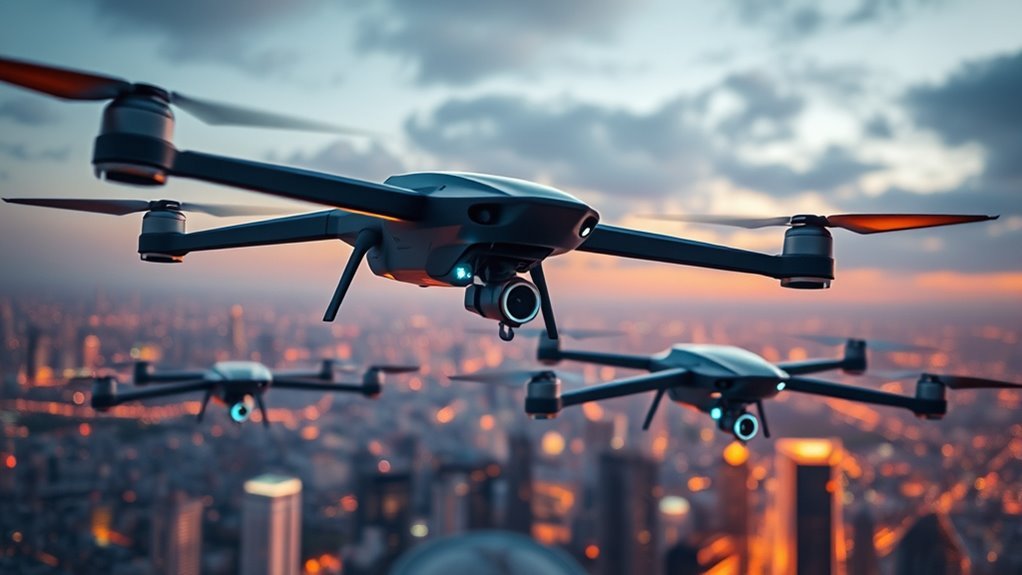In 2025, you’ll see how drone brands harness AI to boost flight safety with real-time obstacle avoidance, using sensors like LiDAR for swift threat detection. It’s enabling autonomous navigation that adapts routes dynamically, while predictive maintenance analyzes data to foresee failures and minimize downtime. AI tailors features to your preferences and navigates regulatory hurdles seamlessly. This overview opens the door to deeper insights on these transformative advancements.
Key Points
- Drone brands use AI for real-time obstacle detection, enhancing flight safety with integrated sensors.
- AI enables autonomous navigation through dynamic route planning and real-time mapping for precise flights.
- Brands leverage AI for predictive maintenance, analyzing data to anticipate and prevent component failures.
- AI adapts drone features based on user feedback, tailoring experiences to meet evolving consumer demands.
- Drone companies employ AI to analyze regulations, ensuring compliance and minimizing legal risks in operations.
AI-Enhanced Obstacle Avoidance Features
As drone technology advances, AI-enhanced obstacle avoidance features have become essential for safer operations. You’ll appreciate how sensor technology integrates AI to detect obstacles in real-time, using tools like LiDAR and cameras to process environmental data swiftly and accurately. This setup analyzes potential threats, allowing your drone to react autonomously and avoid collisions, thereby bolstering flight safety.
In your quest for aerial freedom, these features empower you to navigate open spaces with reduced risks. By minimizing human intervention, AI guarantees that drones maintain stability during flights, preventing accidents that could restrict your explorations. This analytical approach highlights how enhanced sensor technology directly correlates with improved flight safety metrics, such as lower crash rates in varied conditions. Ultimately, it grants you the liberty to innovate and operate drones confidently, fostering a safer, more reliable experience without unnecessary oversight.
Autonomous Navigation Innovations
While drone brands integrate AI for autonomous navigation, you’ll find that these innovations allow your device to map routes and make real-time decisions without constant human input. This empowers you to explore vast areas with greater independence, as real time mapping processes environmental data instantly for precise positioning. Dynamic route planning further enhances this by adapting paths on the fly, minimizing risks and maximizing efficiency in unpredictable conditions.
- Real time mapping analyzes terrain and obstacles in seconds, giving you the freedom to navigate complex spaces without predefined limits.
- Dynamic route planning recalculates courses based on live data, ensuring your drone responds fluidly to changes and maintains operational autonomy.
- Seamless AI integration lets you focus on creativity, as your device handles navigation complexities, fostering a sense of liberation in aerial adventures.
Predictive Maintenance Capabilities
Beyond traditional maintenance schedules, your drone’s AI can now anticipate potential failures by analyzing sensor data in real time, helping you avoid downtime and extend its lifespan. Through advanced sensor integration, your drone collects detailed metrics on components like motors and batteries, feeding this information into AI-driven systems. Data analytics then processes these inputs, identifying patterns that signal wear or potential issues before they escalate. This proactive approach empowers you to maintain control, minimizing unexpected repairs and ensuring seamless operations. For instance, by integrating sensors with machine learning algorithms, you’re freed from rigid maintenance routines, allowing greater flexibility in your aerial adventures. Ultimately, this capability enhances reliability, letting you focus on exploration rather than upkeep, all while optimizing performance through precise, data-informed decisions. It’s a game-changer for independent users seeking autonomy in the skies.
Adapting to Consumer Needs
AI in drones extends its utility by tailoring features to your specific requirements, drawing from user data to enhance personalization. Through sophisticated analysis of customer feedback and market analysis, brands guarantee drones adapt dynamically to your evolving preferences, empowering you to maintain control and independence in your aerial experiences. This approach not only refines functionality but also anticipates needs, fostering a sense of freedom in exploration and innovation.
AI in drones tailors features to your needs, using user data and analysis to adapt dynamically, ensuring control and freedom in aerial adventures.
- Leverage customer feedback: AI processes your input to refine drone interfaces, making adjustments that align with real-time user insights for seamless operation.
- Utilize market analysis: By examining trends, AI predicts emerging demands, allowing brands to customize offerings that give you more choices without constraints.
- Enhance personal autonomy: This data-driven adaptation lets you dictate how drones perform, promoting a liberated experience tailored to your lifestyle goals.
Overcoming Regulatory Hurdles
Regulatory hurdles often complicate drone operations, yet brands are innovatively using AI to guarantee compliance without stifling progress. As you navigate this landscape, you’ll discover how AI tools analyze and adapt to complex legal frameworks in real-time, ensuring your drone activities remain fully compliant while preserving operational freedom. For instance, AI algorithms predict regulatory changes, allowing brands to automate adherence to international standards and avoid penalties that could restrict your innovations.
In 2025, machine learning integrates seamlessly with regulatory compliance protocols, giving you the liberty to focus on creativity rather than bureaucracy. You’ll benefit from AI’s ability to cross-reference flight plans against evolving legal frameworks, minimizing risks and enhancing efficiency. This approach transforms potential obstacles into strategic advantages, empowering you to operate drones with confidence and autonomy, all while maintaining precision and ethical standards.

